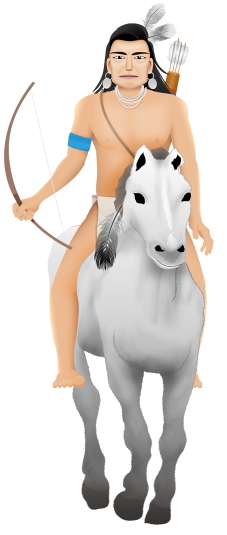It’s not the math that’s hard
Here is a math problem:
Hoksinato and Tasunka Ska are going to steal horses. They could steal the scrub ponies from the edge of the camp. The last 15 times warriors from the tribe tried to steal scrub ponies, they got away 12 times and were caught and tortured 3 times. If they steal the war ponies instead, they will show more bravery, maybe even earn an eagle feather. Plus, war ponies are much more valuable. The last 10 times warriors from the tribe tried to steal war ponies they got away 3 times and were caught and killed 7 times. What is the probability that they will steal the war ponies and get away?
The correct answer is 30%, in other words, 3 out of 10 times.
Another way you could possibly answer it is 12%. You could interpret it as there were 25 attempts at stealing ponies, and that the question was,
What is the probability that they will steal the war ponies AND get away?
In that case, the probability is 40% that they will steal the war ponies (versus the scrub ponies) and 30% that they will get away, .40 *.30 = .12
Thinking about this, I decide to re-word the question. To say,
Hoksinato is not sure whether or not they should try to steal the war ponies. What is the probability that warriors stealing war ponies will get away?
A statistician would immediately think of this in terms of P(A|B) in other words, what is the probability of escape given that they are stealing war ponies? The answer is clearly 30%.
Here is why solving this problem is hard
- It is not worded to be completely clear whether I need to know the probability of getting away when stealing war ponies or the probability of getting away AND stealing war ponies.
- I need to decide which numbers are relevant. For this particular problem, the probability of escaping when stealing scrub ponies is irrelevant.
- I need to decide on the correct operation, in this case, to find the percentage of successful war pony theft attempts, which I find by dividing ten into three.
- Finally, I need to know the answer to 3/10
Why don’t I just ask, “What is the probability of escaping, if a warrior escapes 3 times out of 10?” Because that is a much easier problem. Here’s the kick in the ass – problems in real life don’t come up that way. They occur ambiguously worded with extraneous information thrown in.
Many people, including most of those awarding funding at the National Science Foundation, realize this and thus very strongly urge mathematics programs to teach problem-solving via discovery learning, guided discovery or other methods. These people are right – to an extent. As you can see above, basic mathematics alone won’t solve this problem.
Many other people, including many math teachers at low-performing schools, believe the NSF is run by COMPLETE IDIOTS because the students don’t know the concept of probability, much less P(A|B) , they have no idea of the notation, where to even begin deciding which are the relevant numbers and oh, yes, they can’t divide 10 into 3 and come up with .30 either. These people are also right – to an extent.
If we are going to teach kids math effectively, we need to fund projects that bring these two sides together.
Y’all get on it.


What drives me crazy about these sorts of problems is that so many of them actually poorly written, not just unclear. Directions in general are often poorly written. So when you get to a problem or assignment (or rather, your kid does and they’re asking what the heck they’re supposed to do), it becomes impossible to solve because there is no answer.
Hi, Tammy –
I agree with you. In this particular case, after we wrote the problem the first time, we re-wrote it to be clearer.
The other thing we do with our game is have students in the target age group play it, with our site coordinator in the classroom, so we can note and correct all of the areas of confusion.